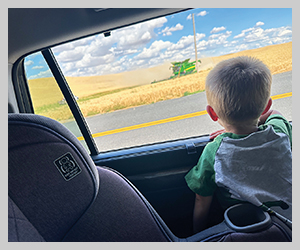What makes a well-designed revenue policy?
2024February 2024
By Curtis Evanenko
McGregor Risk Management Services

Glad tidings readers!
I trust all is well, and you are enjoying the start to 2024. Don’t forget your sweetheart, as it always seems to sneak up on me! The theme of this article is what makes a well-designed revenue policy. In my humble opinion, it depends. We all have a different appetite for risk, and that tolerance will dictate some of one’s policy option choices.
Multiperil crop insurance for wheat in our region has the option of yield protection (YP), which is based on bushels only, or revenue protection (RP), which is a combination of bushels and price. I believe producers in the Pacific Northwest have access to very solid RP policies, and I fully endorse this coverage. Naturally, there is room for some minor improvement tweaks, which, realistically, requires congressional action and/or Risk Management Agency (RMA) language changes. I digress.
Let’s focus on these items:
- Coverage level — up to 85% of historical yields.
- Unit structure — enterprise units, optional units, or a combination of both.
- Policy options.
Realistically, coverage is at the 80% or 85% level. Anything less than this is catastrophic protection, in my opinion. My experience suggests a higher coverage level will correlate to a greater frequency of loss payment. The question is, do you want the maximum protection that 85% offers, or are you willing to share in the risk and pay less premium for 80% coverage? Chart 1 shows the premium subsidy differences by coverage level, which correlates to premium calculations — a lower coverage level is offered a higher subsidy rate.

Unit structure is also a decision that considers one’s appetite for risk. Optional units (OU) structure can be as simple as a different, separate unit by section or farm location. This means that the production of one OU does not impact the production of another OU.
Enterprise units can be defined as all like crop in the county — all fall wheat acres for example — are in a single unit. EU will have the exact same liability coverage as OU but enjoys a premium discount from RMA by sharing in the risk coverage. EU has the same dollars of coverage as OU, yet can have up to a 30% premium savings due to a higher premium subsidy. The amount of premium savings is dependent upon the number of acres and locations: the greater of each, the greater the premium discount.
A recent policy change now allows EU structure by wheat type, i.e., fall wheat and spring wheat, which could be two separate EU in the county. Additionally, one could mix and match — EU for all fall wheat acres, and OU for all spring wheat acres, or vice versa.
The last item for consideration would be what I call alphabet soup; there are a host of acronym policy coverage options that I feel are mandatory to the policy:
- QL (quality loss). This allows net bushels for production history; think falling numbers discounts.
- TA (trend adjustment). This takes into account today’s potential for higher yields vs. the current historical yield average due to advances in fertility, genetics, and plant health.
- YA (yield adjustment). If the harvested yield is less than 60% of the county T-Yield, the factored T-Yield is used to maintain a higher actual production history database average.
- YC (yield cap). When a new yield is added to the database, this prevents the average yield from declining more than 10% and helps maintain a higher, historic average yield.
- YE (yield exclusion). This allows a yield year, as determined by RMA, to be excluded from the 10-year database. If there is a year excluded, 2021 for example, the database becomes a nine-year historical average.
- WCE (Winter Coverage Endorsement). This option would allow additional policy choices in the event fall-planted crop does not survive the winter.
In short, risk appetite determines policy coverage options. Depending on one’s location and rotations, I would entertain an 85% coverage level along with the EU structure and alphabet soup for options. I’d want the highest coverage level available, providing the most dollars of liability at an affordable price.
I wish all a great spring season. Until next time, square corners.
Curtis Evanenko serves as a risk management advisor with McGregor Risk Management Services. He can be reached at (509) 540-2632 or by email at cevanenko@mcgregorrisk.com.












